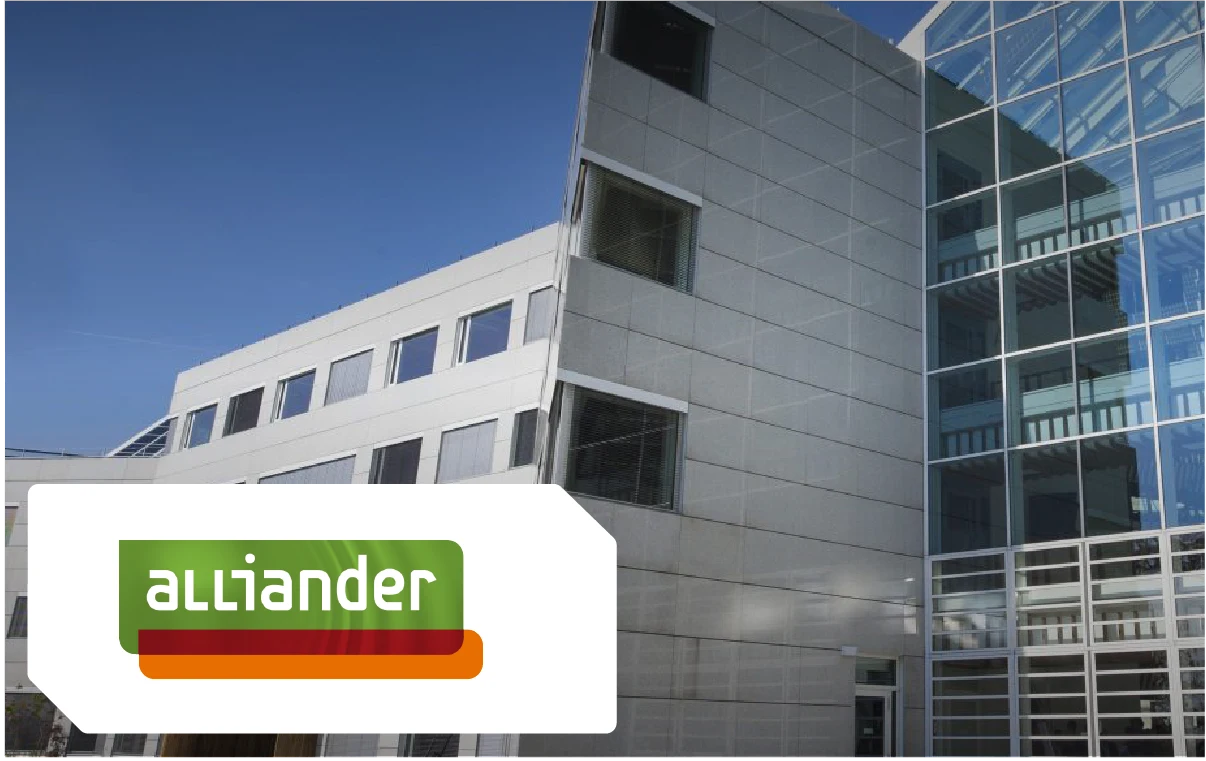IT Strategic Planning: Driving Business Innovation and Resilience
Aligning IT and business strategies is essential for driving innovation and enhancing resilience nowadays. This document equips Strategic Planning and Enterprise Architecture (EA) leaders with the tools, frameworks, and insights necessary to achieve this alignment.
By leveraging EA and IT Strategic Planning, organizations can:
- Smoothly integrate new technologies,
- Proactively manage risks,
- Tie IT investments to business outcomes.
Aligning IT with the business, driven by Enterprise Architecture, is crucial for navigating everyday risks, fostering innovation, and building business resilience.
Positioning your company’s EA tool as an essential solution for achieving these goals is imperative.
The Evolving Role of IT in Business
IT has evolved from a back-office support function to a critical strategic partner in driving business success. Today, technology decisions are business decisions, and IT leaders like CIOs are responsible for operational efficiency and overall business strategy.
From a Support Function to a Strategic Partner
Traditionally seen as a cost center, IT is now integral to business innovation and growth. CIOs are increasingly assessed on their capacity to deliver tangible business outcomes, including increased revenue and a competitive advantage in the marketplace. IT has shifted from simply maintaining systems to becoming a strategic driver for business success.
Effective IT management can improve operational efficiency, customer experiences, and the ability to quickly adapt to market changes. Today, IT enhances value creation and aligns with business goals by using advanced technologies, fostering collaboration, and enabling data-driven decision-making.
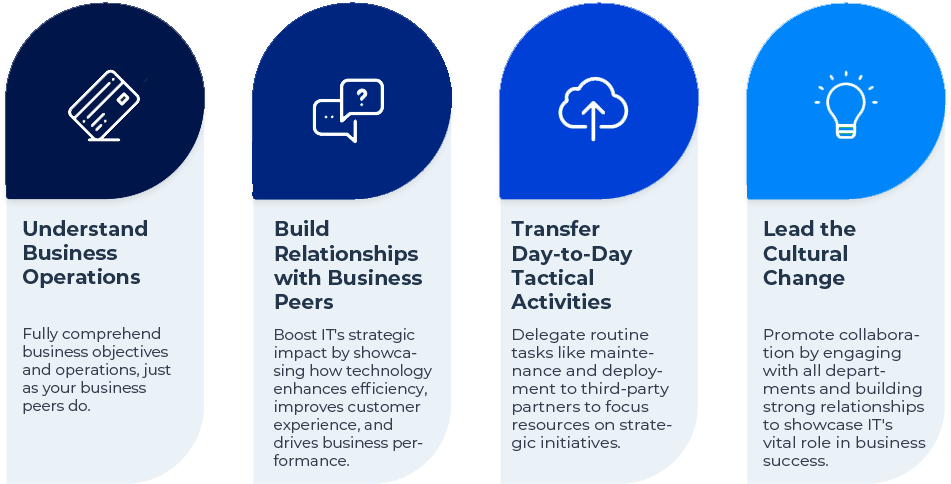
The Imperative of IT-Business Alignment and Enterprise Architecture
Aligning IT with business objectives is essential to staying competitive. Companies must improve efficiency, and delays, while competitors use technology to drive growth and agility.
Effective IT-business alignment ensures that technology investments directly contribute to achieving business goals. By working closely with business leaders, IT can shift from reactive to proactive, supporting key initiatives, driving innovation, and enabling rapid responses to market changes.
Enterprise Architecture is the key to achieving this alignment. It provides a clear blueprint for how technology supports business goals and ensures that all IT projects, from transformations to infrastructure upgrades, are directly tied to business priorities. By adopting EA frameworks, organizations can streamline operations, improve agility, and keep long-term goals in focus. As businesses continue to face disruption, IT’s strategic role will only increase.
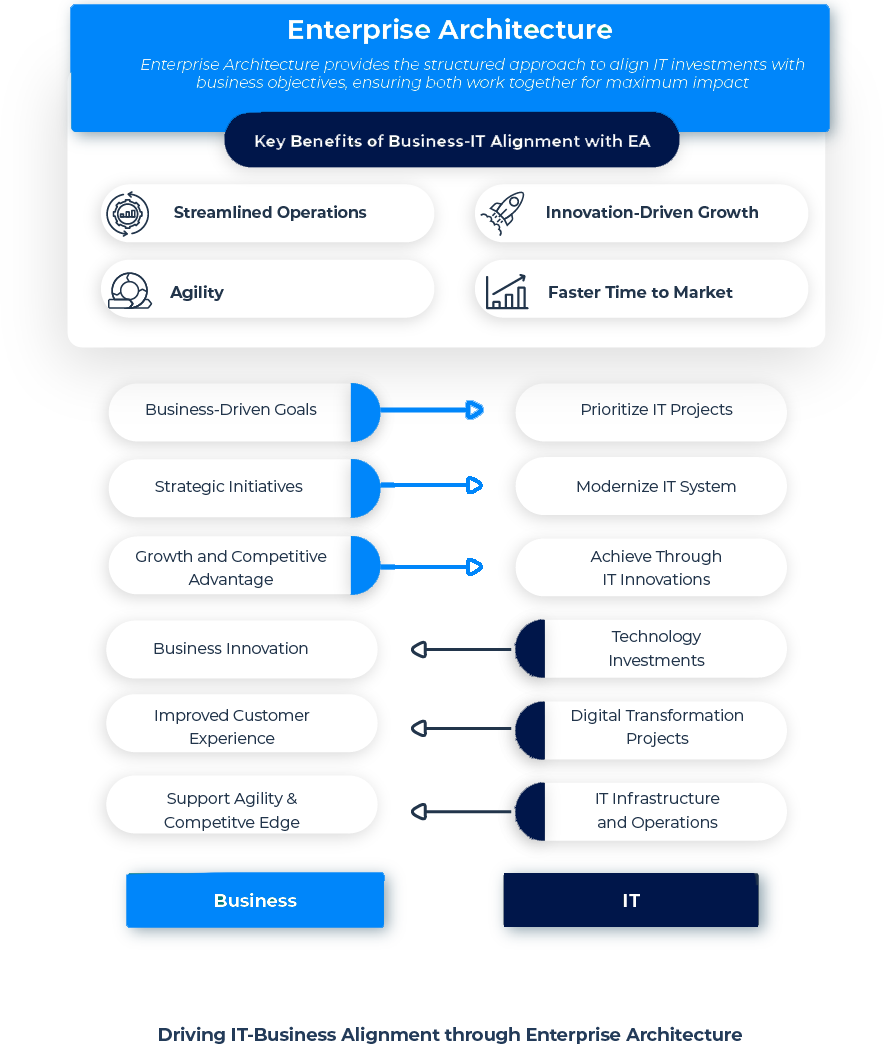
Navigating Risks, Driving Innovation, and Building Resilience
Today’s organizations face an unprecedented array of risks, ranging from cyber threats to regulatory changes and market volatility. Rapid technological advancements, such as cloud computing, AI, and IoT, further complicate the landscape. If not effectively managed, these risks can disrupt operations, damage reputations, and erode customer trust. To stay competitive and resilient, businesses must manage these risks and use them as catalysts for innovation.
Understanding Business Risks
Businesses must be prepared for rapid shifts. Cybersecurity threats continue to evolve, and regulatory requirements are becoming more stringent. Technological disruptions can render even the most advanced systems obsolete if organizations are unprepared to adapt. Enterprise Architecture is critical in identifying vulnerabilities and planning for contingencies.
By leveraging EA, businesses can gain a holistic view of their IT landscape and pinpoint potential risks before they become threats. This approach ensures that organizations can withstand disruptions and are well-positioned to capitalize on new opportunities as they arise.
Driving Innovation Through IT-Business Alignment
Innovation thrives when IT and business are aligned. Emerging technologies such as artificial intelligence (AI), microservices, and cloud computing offer incredible opportunities for businesses to reinvent themselves but also come with challenges. To successfully integrate these technologies, it’s essential to have a clear strategic framework that aligns IT initiatives with business goals.
Enterprise Architecture provides a framework that enables businesses to evaluate the impact of new technologies, identify high-value use cases, and ensure seamless integration with existing systems. With EA, organizations can map technological innovations directly to business goals, discovering new ways to streamline operations, enhance customer experiences, and reduce costs.
- Leveraging AI: AI can potentially transform industries, but it must be strategically deployed. With EA, organizations can identify the best use cases for AI, plan the necessary infrastructure, and ensure seamless integration with current systems. This results in optimized operations and improved business outcomes.
- Harnessing Cloud and Microservices: Cloud computing and microservices offer flexibility and scalability, but require careful planning to maximize their benefits. EA helps design IT architectures that leverage these technologies while managing associated risks, ensuring agility and resilience.
"You need to operate your capabilities with sound financial management capabilities, but it’s really about mapping the cost to the value that you are delivering. That’s where enterprise architecture is crucial to balance this equation between innovation and legacy technology management."
Source: Fred Giron - Futurecio.tech
Building Organizational Resilience with Enterprise Architecture
A resilient organization can navigate crises, sustain its operations, and seize new opportunities. Enterprise Architecture is essential in building this resilience by providing a comprehensive view of the IT landscape and enabling proactive risk management.
- Proactive Risk Management: EA helps organizations spot weaknesses in their IT infrastructure and take steps to mitigate risks. By managing risks proactively, businesses can minimize vulnerabilities and maintain continuity.
- Scenario Planning and ‘What-If’ Analysis: EA supports scenario planning by enabling organizations to simulate different contingencies and their effects on operations. This prepares businesses for outcomes like cyber-attacks or system failures, ensuring they have effective response strategies in place.
- Agility and Continuous Adaptation: EA enables the creation of agile IT systems that can swiftly scale, adopt new technologies, and respond to market changes. This agility is essential for meeting customer needs and staying competitive.
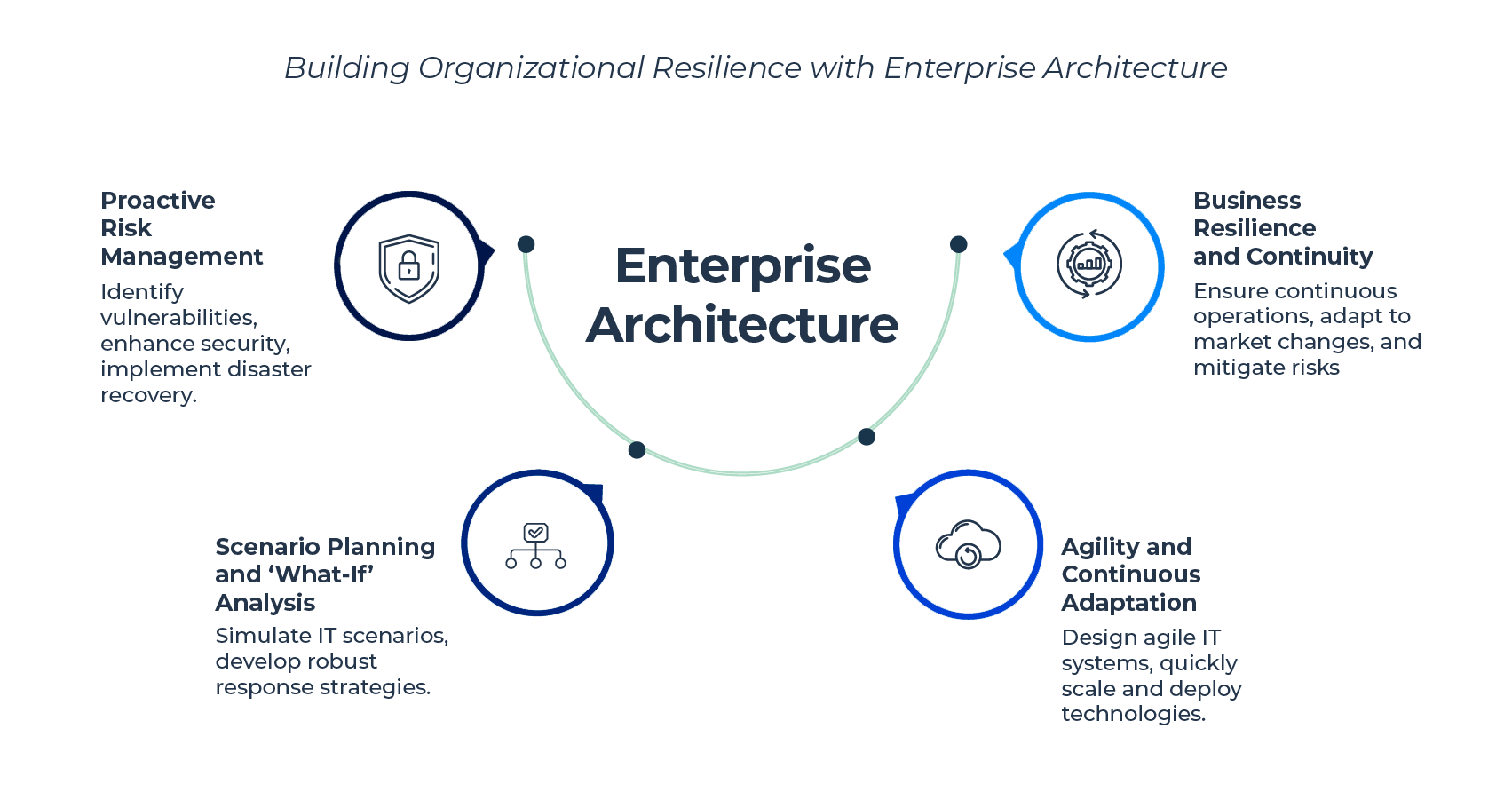
IT Strategic Planning for IT-Business Alignment
IT Strategic Planning is setting long-term IT goals that directly align with the overall business objectives. It ensures that technology investments are reactive and proactive in supporting the business strategy. This planning involves identifying key IT investments, prioritizing projects, and creating a roadmap to guide IT activities over time. Through Enterprise Architecture, IT Strategic Planning, and Strategic Portfolio Management become a structured, agile approach that continuously adapts to changing business needs and technological advancements.
Defining IT Strategic Planning?
At the core of IT Strategic Planning is aligning IT initiatives with business goals. This alignment ensures that every IT project delivers measurable business value, from system upgrades to digital transformation efforts.
The process involves:
- Setting Strategic IT Goals: These long-term goals align with the company’s strategy, focusing on enhancing customer experience, cutting costs, and facilitating new product launches.
- Identifying Key IT Investments: Prioritize which IT projects and technologies will drive the most significant business impact.
- Creating an IT Roadmap: A detailed plan that outlines the steps to achieve these goals, with specific timelines and milestones.
When IT Strategic Planning is well-executed, IT drives business innovation, operational efficiency, and organizational resilience.
How Enterprise Architecture Facilitates IT Strategic Planning
Enterprise Architecture provides a structured approach for effective IT Strategic Planning. By offering a holistic view of the organization’s IT landscape, EA enables IT leaders to:
- Map Current and Future IT Landscapes: EA helps visualize the current state of IT systems and infrastructure, identifying inefficiencies, gaps, or areas that need improvement. It then guides the design of a future-state architecture that aligns with the company’s strategic goals.
- Link IT Investments to Business Outcomes: EA ensures that every IT initiative is directly tied to a business objective, making it easier to justify investments and measure their impact.
- Enable Agile, Scalable IT Systems: As the business environment evolves, so must the IT systems. EA helps design flexible and scalable architectures that adapt to changing business needs without requiring disruptive overhauls.
By embedding EA into IT Strategic Planning, organizations can continuously assess and refine their IT strategy, ensuring it remains aligned with business priorities.
The Benefits of IT-Business Alignment
Aligning IT and business strategies delivers several key benefits:
- Improved Decision-Making: Clear alignment enables informed decision-making, ensuring that IT investments are strategically sound.
- Optimized Resource Allocation: IT resources are directed toward projects with the most significant business value.
- Accelerated Innovation: Alignment fosters an environment where new technologies (such as AI, cloud, or microservices) can be rapidly integrated to drive innovation.
- Increased Resilience: A well-aligned IT strategy supports business continuity and resilience, enabling organizations to adapt to disruptions and maintain operations.
Identifying IT Projects to Support Business Goals
Identifying suitable projects is one of the biggest challenges in aligning IT with business strategy. EA tools play a critical role here by offering a clear view of the IT landscape and how it relates to business capabilities. These tools help organizations:
- Map Business Capabilities to IT Solutions: EA tools provide insights into how existing IT systems support business goals, revealing gaps where new investments are needed.
- Prioritize IT Investments: EA tools allow organizations to prioritize projects based on strategic value, cost, and return on investment (ROI) by analyzing the potential impact of IT projects on business outcomes.
- Simulate Future Scenarios: EA tools enable organizations to run ‘what-if’ scenarios, helping them understand the implications of different IT strategies before implementation. This ensures that selected projects align with long-term business goals.
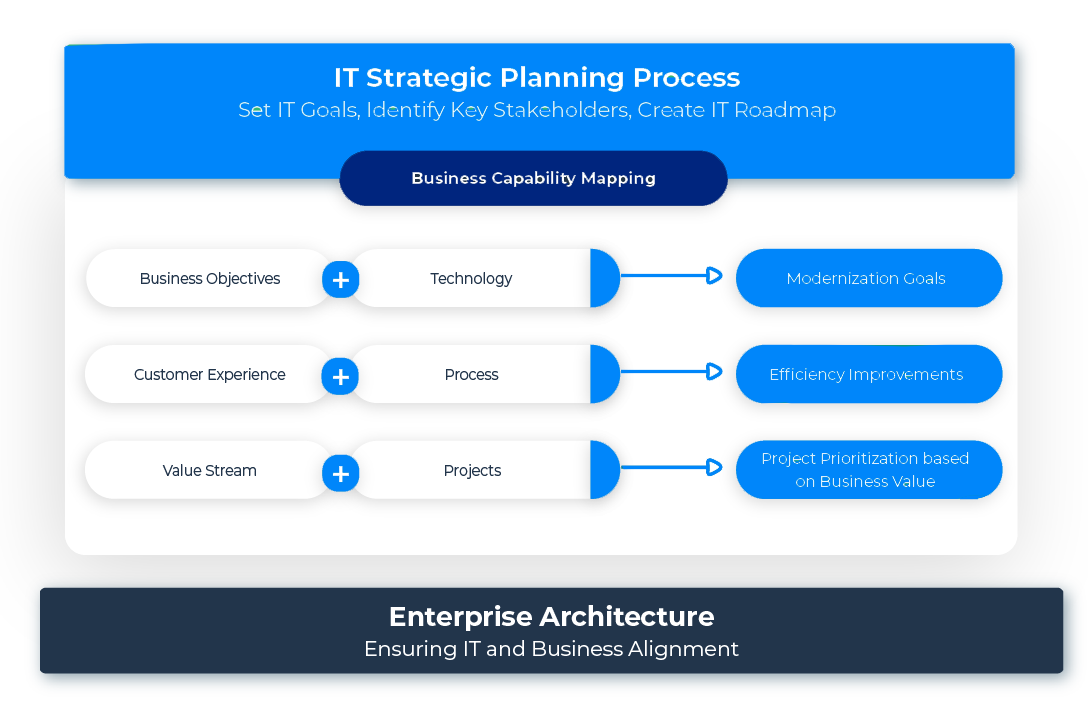
Conclusion: IT Strategy Planning for growth and success
IT Strategic Planning is essential for driving business success. Aligning IT with business goals ensures that every investment delivers value, fuels innovation, and enhances organizational resilience. By leveraging Enterprise Architecture, companies can set clear IT goals, optimize resources, and create flexible, scalable systems that adapt to change.
Bizzdesign's Enterprise Transformation Suite offers the tools you need to achieve this alignment. With our products, you can:
- Map business needs to IT systems for better alignment.
- Prioritize IT investments based on impact and ROI.
- Simulate future scenarios to make informed decisions.
Unlock the full potential of IT Strategic Planning and ensure your IT drives business success now.



